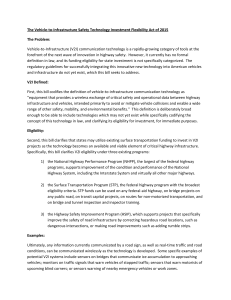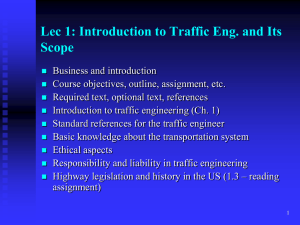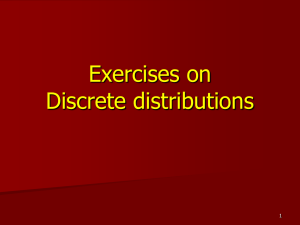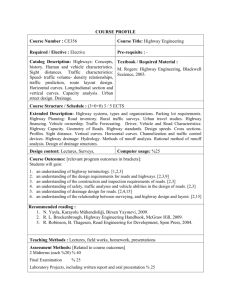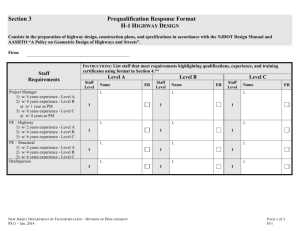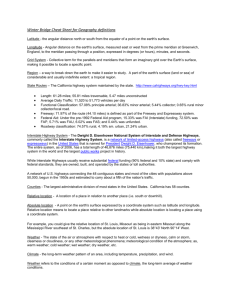COMMONWEALTH OF PENNSYYLVANIA
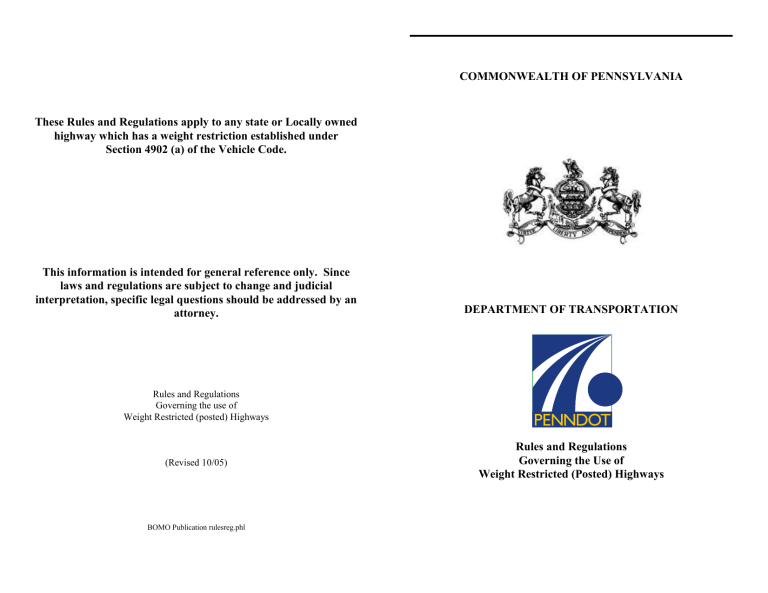
These Rules and Regulations apply to any state or Locally owned highway which has a weight restriction established under
Section 4902 (a) of the Vehicle Code.
This information is intended for general reference only. Since laws and regulations are subject to change and judicial interpretation, specific legal questions should be addressed by an attorney.
Rules and Regulations
Governing the use of
Weight Restricted (posted) Highways
(Revised 10/05)
BOMO Publication rulesreg.phl
COMMONWEALTH OF PENNSYLVANIA
DEPARTMENT OF TRANSPORTATION
Rules and Regulations
Governing the Use of
Weight Restricted (Posted) Highways
COMMONWEALTH OF PENNSYLVANIA
DEPARTMENT OF TRANSPORTATION
Rules and Regulations Governing the Use of Weight Restricted
(Posted) Highways
PENNSYLVANIA CONSOLIDATED STATUTES
TITLE 75 VEHICLES (Vehicle Code)
Chapter 49 -- Size, Weight and Load
§ 4902. Restrictions on use of highways and bridges.
(a) Restrictions based on condition of highway or bridge.
—
The Commonwealth and local authorities with respect to highways and bridges under their jurisdictions may prohibit the operation of vehicles and may impose restrictions as to the weight or size of vehicles operated upon a highway or bridge only when they determine by conducting an engineering and traffic study as provided for in department regulations that the highway or bridge may be damaged or destroyed unless use by vehicles is prohibited or the permissible size or weight of vehicles is reduced. School buses, emergency vehicles and vehicles making local deliveries or pickups may be exempted from restrictions on the use of highways imposed under this subsection.
(b) Restrictions based on traffic conditions.
—
The Commonwealth and local authorities with respect to highways and bridges under their jurisdictions may prohibit the operation of vehicles and may impose restrictions as to the weight or size of vehicles operated upon a highway or bridge whenever they determine that hazardous traffic conditions or other safety factors require such a prohibition or restriction. School buses, emergency vehicles and vehicles making local deliveries or pickups may be exempted from restrictions on the use of highways imposed under this subsection.
(c) Permits and security.
—
The Commonwealth and local authorities may issue permits for movement of vehicles of size and weight in excess of restrictions promulgated under subsections (a) and (b) with respect to highways and bridges under their jurisdiction and may require such undertaking or security as they deem necessary to cover the cost of repairs and restoration necessitated by the permitted movement of vehicles. In reference to subsection (a), the
Commonwealth and local authorities shall not refuse to issue a permit with respect to a highway under their jurisdiction if there is no reasonable alternate route available. For purposes of this section, “reasonable alternate route” shall mean a route meeting the criteria set forth in department regulations relating to traffic and engineering studies.
(d) Designation of alternate routes .
—
(1) In conjunction with the exercise of the powers set forth in subsections
(a) and (b), the Commonwealth may designate alternate routes for vehicles in excess of specified weights or sizes. Such alternate routes may utilize portions of the Pennsylvania Turnpike.
__________________________________________________________________
This Publication was prepared by the
Bureau of Maintenance and Operations of the
Pennsylvania Department of Transportation.
Rule and Regulations
Governing the use of
Weight Restricted (Posted) Highways
(Revised 3/06)
__________________________________________________________________
(2) In conjunction with the exercise of the powers set forth in subsection
(c), when refusing to issue a permit with respect to a highway under their jurisdiction, the Commonwealth and local authorities may conduct or cause to be conducted an alternate route study. The elements of an engineering and traffic study conducted to designate an alternate route pursuant to this section shall consist of the same elements found in department regulations.
(e) Erection of signs .—
The Commonwealth and local authorities shall erect or cause to be erected and maintained restriction signs designating the restrictions at each end of a bridge or portion of highway restricted as provided in subsection (a) or (b). In the case of a restriction on a bridge or on a highway which does not begin or end at an intersection with an unrestricted highway, the
Commonwealth or local authorities shall also place an advance informational sign at the intersection nearest each end of the restricted bridge or portion of highway which would allow drivers to avoid the restricted bridge or portion of highway. No person shall be convicted of violating subsection (a) or (b) unless the restriction sign designating the restricted bridge or portion of highway to traffic moving in the direction the person was driving was posted as required in this subsection.
However, failure to post the restriction sign designating the restricted bridge or portion of highway to traffic moving in the opposite direction or failure to post any advance informational sign shall not constitute a defense to a violation of this section.
(f) Actions to be in accordance with department regulations . All actions taken under authority of this section shall be taken in accordance with department regulations.
(f.1) Local ordinances superseded.
—Notwithstanding any other provision of law, local authorities are prohibited from enacting or enforcing ordinances inconsistent with the provisions contained in this section.
(g) Penalty ------
(1) Any person operating a vehicle or combination upon a highway or bridge in violation of a prohibition or restriction imposed under subsection (a) is guilty of a summary offense and shall, upon conviction, be sentenced to pay a fine of $75, except that any person convicted of operating a vehicle with a gross weight in excess of a posted weight shall, upon conviction, be sentenced to pay a fine of
$150 plus $150 for each 500 pounds, or part thereof, in excess of 3,000 pounds over the maximum allowable weight.
(2) Any person operating a vehicle or combination in violation of a prohibition or restriction imposed under subsection (b) is guilty of a summary offense and shall, upon conviction, be sentenced to pay a fine of not less than $25 and not more than $100.
§ 4907. Penalty for violation of chapter.
(a) General rule— Any person violating any provision of this chapter for which a penalty is not otherwise provided commits a summary offense and shall, upon conviction, be sentenced to pay a fine of $300 for each violation.
(b) Penalty for violation of permit.
—Any person whose vehicle, combination or load is in violation of or not in compliance with any condition of a permit and any person who violates or fails to comply with any condition of a permit while operating or transporting a vehicle, combination, or load, in addition to any other violation prohibited by this chapter, commits a summary offense and shall, upon conviction, be sentenced to pay a fine of $500 for each violation.
(c) Penalty for violation of multijurisdictional permit.
—Any person who violates or fails to comply with any provision of a permit issued under section
6146.1 (relating to multijurisdictional permit agreement), in addition to any other violation prohibited by this title, commits a summary offense and shall, upon conviction, be sentenced to pay a fine of $500 for each violation.
(d) Penalty for operation with an invalid permit.
—Any person who operates or moves an oversize or overweight vehicle, combination or load with an expired, void or invalidated permit, in addition to any other violation prohibited by this chapter, commits a summary offense and shall, upon conviction, be sentenced to pay a fine of $1,000 for each violation.
(e) Failure to properly administer, adhere to and enforce the requirements of this chapter.
—When it is determined in a summary proceeding that a local authority has failed to comply with any of the requirements of this chapter or the department’s concomitant regulations, the following shall occur:
(1) The local authority shall be liable for the costs for scheduling and
conducting the proceeding and for the reasonable costs incurred to respond to
and defend against the charges. The costs shall be assessed by the magisterial
district judge and payable within 30 days of assessment.
(2) The local authority shall forfeit any right of recovery for the cost of any
repairs and restoration necessitated by the movement of vehicles upon highways
or bridges.
PENNSYLVANIA CONSOLIDATED CODE
TITLE 67 TRANSPORTATION
Chapter 189 -- Hauling in Excess of Posted Weight Limit
Section 189.1. Scope; Authority .
(a) This chapter regulates the use of highways posted with weight restrictions authorized under Section 4902 of the Vehicle Code (75 Pa. C.S. section 4902) by vehicles and combinations having a gross weight in excess of the posted weight limit, and applies to both State highways and highways under the jurisdiction of local authorities.
(b) This chapter is promulgated under authority of Sections 4092 and 6103 of
(2) Determination by posting authority. If Multiple applicants for Type 1 or
Type 2 permits cannot agree on their relative responsibility, the posting authority will determine their relative shares, and will enter into agreements with and accept security from any person agreeing to such determination.
(3) Subsequent permit applicants. Paragraphs (1) and (2) shall apply even if one or more persons have already entered into a Type 1 or Type 2 permit agreement and posted security when another person expresses the desire to obtain a
Type 1 or Type 2 permit to operate over-posted-weight vehicles on the same posted highway.
(f) Determination of highway condition. Determination of highway condition shall consist of the following:
(1) Inspection. Representatives of the posting authority and of the permittee or permittees will make an onsite inspection of the posted highway immediately before issuance of each permit in order to determine its condition.
(2) Re-inspection. The posted highway will be re-inspected:
(i) upon issuance of any new permit;
(ii) from time to time as the posting authority determines repairs may be required; and
(iii) upon termination of any permit, in order to determine the amount of damage for which the permittee or permittees are responsible.
(3) Type 3 permits. Before and after using a Type 3 permit on any posted highway specified in the permit, the representatives of the permittee and the posting authority will make an onsite inspection to determine the relative condition of the highway before and after the use and to assess any excess maintenance caused by the permittee.
(4) Notification of inspections and re-inspections. All Type 1 and Type 2 permittees on a posted highway or portion thereof will be notified of all inspections and re-inspections on the highway or portion, and may participate in the inspections and re-inspections.
(5) Inspection costs. The inspection costs of the posting authority shall be paid by the permittee or permittees. Inspection costs related to a County wide or municipality wide
Type 3 permit will be paid solely by the Type 3 permittee.
(g) Administrative fee. The Department will charge a $15 administrative fee for issuance of each Type 3 permit. Local authorities may charge an administrative fee of no more than $15 for issuance of each Type 3 permit. the Vehicle Code (75 Pa. C.S. sections 4902 & 6103).
(c) The provisions of this chapter apply to bridges located on posted highways but do not apply to bridges posted independently of highways.
Section 189.2. Definitions.
The following words and terms, when used in this chapter, shall have the following meanings, unless the context clearly indicates otherwise:
Excess maintenance -- Maintenance or restoration or both (but not betterment) of a posted highway in excess of normal maintenance, caused by use of over-posted-weight vehicles.
Local traffic -- The following shall be regarded as local traffic for the
Purposes of Section 189.3 of this title (relating to local traffic):
(1) Emergency vehicles;
(2) School buses;
(3) Vehicles and combinations of governmental agencies and utilities or their contractors engaged in construction or maintenance on a posted highway or in a location which can be reached only via a posted highway; and
(4) Vehicles and combinations going to or coming from a residence, commercial establishment, or farm located on a posted highway or which can be reached only via a posted highway.
Normal maintenance -- The usual and typical activities necessary to maintain the roadway, shoulders, and drainage facilities in the state of repair existing at the date of the inspection prescribed in section 189.4(f)(l) of this title (relating to use under permit).
Over-posted-weight vehicle -- A vehicle or combination having a gross weight in excess of a posted weight limit.
Posted highway -- A highway having a posted weight limit.
Posted weight limit -- A restricted weight limit posted on a highway under authority of section 4902 of the Vehicle Code (75 Pa. C.S. section 4902).
Posting authority -- The Department, as to the State designated highways, and local authorities, as to all other streets and highways.
Section 189.3. Local traffic.
(a) General rule . Over-posted-weight local traffic may exceed posted weight limits unless the posting authority determines that an over-posted-weight vehicle or vehicles being driven to or from a particular destination or destinations are likely to damage the highway.
(b) Vehicles determined likely to damage highway . If the posting authority determines that one or more over-posted-weight vehicles are likely to damage the highway, the posting authority will so notify the registrants of the over-posted-weight vehicles or owners of the destination or destinations, or both, and will also notify State and local police. After 2 business days following delivery of the notice, or after 5 days following mailing of the notice, such over-posted-weight vehicles shall not exceed the posted weight limits except in accordance with the provisions of Section 189.4 of this title (relating to use under permit).
(c) Proof of local traffic status . The following types of documents will constitute evidence that a vehicle is local traffic:
(1) A bill of lading, shipping order, or similar document which shows a destination on the posted highway.
(2) Certification by the permittee or an official of a permittee company on
the company letterhead describing the local traffic nature of the activity which the vehicle is engaged in.
Section 189.4. Use under permit .
(a) General rule . No over-posted-weight vehicle, except local traffic authorized under section 189.3(a) of this title (relating to local traffic), shall be driven on a posted highway with a gross weight in excess of the posted weight limit unless the posting authority has issued a permit for the vehicle or vehicles in accordance with this section.
(b) Type of permits . Types of permits shall include the following:
(1) A Type 1 permit authorizes use of a particular posted highway or portion thereof by an over-posted-weight vehicle. It is valid only when carried in the over-posted-weight vehicle.
(2) A Type 2 permit authorizes use of a particular posted highway or portion thereof by any number of over-posted-weight vehicles being driven to or from a common destination.
(i) Documents of the type set forth in Section 189.3(c) of this title
(relating to local traffic) will constitute evidence of the destination of a vehicle.
(ii) A Type 2 permit will be issued only upon request of the permittee and if the posting authority determines that it is not feasible to issue a
Type 1 permit for each vehicle, for example, most over-posted-weight vehicles hauling to and from the place of business of the permittee belong to or are hauling under contract with customers or suppliers of the permittee.
(3) A Type 3 permit authorizes use of a number of specified posted highways or portions thereof by an over-posted-weight vehicle.
(i) A Type 3 permit is valid only when carried in the over-posted-weight vehicle.
(ii) A Type 3 permit is issued only if the posting authority determines that damage to the posted highway covered by the permit will be minimal because of the limited number of moves by over-posted-weight vehicles and short term use of the highways anticipated by the permittee.
(c) Excess maintenance agreement . Issuance of a permit to exceed a posted weight limit or limits will be conditioned on the agreement by the permittee to accept financial responsibility for excess maintenance of the posted highway or portion thereof to be used by the permittee. The agreement may provide for the work to be performed by the posting authority or its contractor or by the permittee or its contractor, except that in the case of a self-bond agreement, the Department will require that all work be performed by the permittee or its contractor.
(d) Security. Except as provided in Paragraph (4) of this subsection, the permittee shall be required to provide security in favor of the posting authority to assure compliance with the maintenance-reconstruction agreement.
(1) Amount of security. Amount of security shall be as follows:
(i) Type 1 and 2 permits. Type 1 and 2 permits shall include:
(A) $6,000 per linear mile for unpaved highways to be maintained at a level consistent with the type of highway.
(B) $12,500 per linear mile for paved highways to be maintained at a level consistent with the type of highway.
(C) $50,000 per linear mile for any highway which the posting authority allows to be maintained below a level consistent with the type of highway.
(ii) Type 3 permits. $10,000 for each county or municipality covered by the permit.
(iii) Schedule of bonding amounts. The Department will from time to time, but not more often than annually, publish a revised schedule of bonding amounts based on increased or decreased maintenance costs.
(2) Form of security. The security may be in the form of a performance bond with surety by a company authorized to do business in the Commonwealth; or, at the option of the permittee, in the form of a certified or cashier's check, bank account, or irrevocable letter of credit in favor of the posting authority; or in some other form of security acceptable to the posting authority.
(3) Additional security. When the amount of damage in excess of normal maintenance to a posted highway is estimated by the posting authority to constitute
75% or more of the amount of the security, the posting authority may require the highway to be maintained or reconstructed within 30 days unless the permittee agrees to provide such additional security as the posting authority shall determine.
(4) Self-bonding. The posting authority may authorize self-bonding if it determines, on the basis of the financial ability of the permittee, that it is unlikely that the posting authority will be unable to collect a judgment rendered against the permittee for failure to comply with the maintenance agreement.
(i) The posting authority may require corporate officers and stockholders and their spouses to execute a self-bond, if the financial ability of a corporation is insufficient in itself to justify self-bonding.
(ii) The posting authority may require the permittee to execute liens on real or personal property, or both, as a condition for authorizing self-bonding.
(iii) In order to be considered for self-bonding by the Department, a permittee shall file Contractor's Financial Statement, Department Form CS
4300, Part 1. The financial statement shall be updated annually, and within 30 days of any Department request for an update.
(e) Multiple permittees. Multiple permittees shall conform with the following:
(1) Agreement to share excess maintenance responsibility. If two or more persons wish to obtain Type 1 or Type 2 permits to operate over-posted-weight vehicles on the same posted highway or portion thereof, they may agree among themselves as to their relative responsibility for the cost of excess maintenance and the posting authority will enter into agreements and accept security on the basis of the agreed shares.

